The X Button
Metal Circus
by Todd Ciolek,

As someone who's done time at magazines and newspapers, I know how hard it is to keep up with the all-destroying news machine of the Internet. That's why I'm a little cheered up whenever a game magazine springs news before any uncouth website does. This happened twice last week. Nintendo Power announced that Tatsunoko vs. Capcom is coming to North America, and then Famitsu, Japan's largest gaming mag, revealed Banpresto's Super Robot Academy.
In Famitsu's case, their scoops are helped more than a little by the fact that they're a weekly magazine, one controlled by Japan's game companies in ways that would make the typical serious-minded journalist cringe and dive further into alcoholism. What's more, Famitsu exclusives are only exclusives until someone scans the relevant pages and plasters them on forums everywhere, which usually happens twenty minutes after an issue is printed. Oh well. I'm just glad that a magazine can still get people talking.
NEWS
SUPER ROBOT WARS IN SCHOOL
Super Robot Wars already has several spin-offs, including the Original Generation line and Endless Frontier, an RPG full of anime overkill and cleavage jokes. What follows in the natural evolution of a major otaku-oriented franchise? A game set at a high school, that's what. The DS game Super Robot Academy (or Super Robot Gakuen, for the purists) stages its robot-anime crossovers at a institute of private secondary education, where a teenager named Ryoga and his friend Sakuya (who dresses like the heroine of a dating-sim/RPG) stumble across all sorts of familiar giant robots.
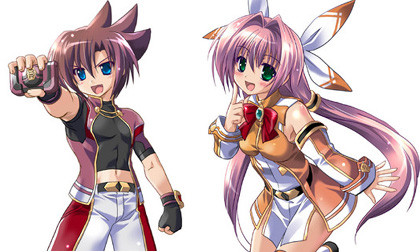
Early descriptions suggest that the game's orgy of anime mecha icons will be framed as some virtual-reality battle simulator, but I hope that's not true. Anyone who buys this game will want to see GaoGaiGar's Guy and G Gundam's Domon Kasshu fistfight in the cafeteria. And that's what they should get, even if they'll have to import it this fall. It's not coming to the U.S. unless someone overcomes that monstrous licensing hurdle.
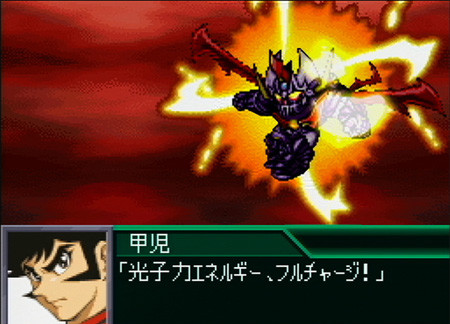
The official website hasn't yet listed the robot series on display in Super Robot Academy, but eager fans have already rounded up what's been shown. It's a good sampling of series from past titles, drawing in '80s also-rans like Zeorymer and Dancougar as well as the usual spate of Gundams and Go Nagai robots. It bothers me to see that lousy The Prince of Darkness movie represent Nadesico, but I guess the film had prettier robots.
LUNAR: THE SILVER STAR COMES TO THE PSP
If memory serves, Lunar: The Silver Star has been available on the Sega CD, the PlayStation, the Saturn, the GameBoy Advance, and, in Japan and Korea, the PC. A PSP remake of the game was perhaps inevitable, and that's what the Lunar creators at GameArts and their new parent company, GungHo, have planned. Not that I blame them. Lunar: The Silver Star was a massive cult hit on the Sega CD in 1993 and again on the PlayStation in 1999. It still has fans today, even though this decade's only new Lunar entry was the unspeakably boring Dragon Song for the DS. Fans still prize the first two Lunar games, and while some (myself included) prefer the second, there's much fondness for the first game's tale of an aspiring swordsman and his pet dragon going to taxing lengths to rescue his girlfriend from world-wrecking forces. Cliché? Yes, but Lunar had stunning animated cutscenes, solid gameplay, and, thanks to U.S. publisher Working Designs, an English script far more appealing than the dreary translations slapped on other RPGs of the 1990s.
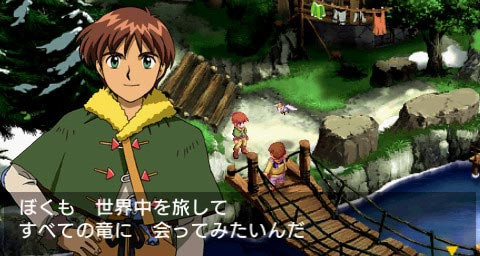
The PSP version, known as Harmony of the Silver Star, is no lazy port of a previous game, as the character sprites are clearly new and the backgrounds now have that isometric look.

On the other hand, the video sequences seem to come straight from the PlayStation and Saturn versions of the games. Don't expect too many changes to the storyline. Hope instead that GungHo and whatever's left of GameArts will perk up the somewhat dated battle mechanics. Also hope that the localization is good enough to smooth over the trite qualities of Lunar, as Working Designs smoothed them over many years ago.
TATSUNOKO VS. CAPCOM ON THE WII, IN ENGLISH
Finally. Tatsunoko vs. Capcom was too big to avoid a North American release, and Capcom recently announced that the Wii version of the game is headed here later this year. Let's set aside the fact that there's no online mode (yet) and that you'll need something other than the Wii remote to play it properly. It's still Tatsunoko vs. Capcom in English.
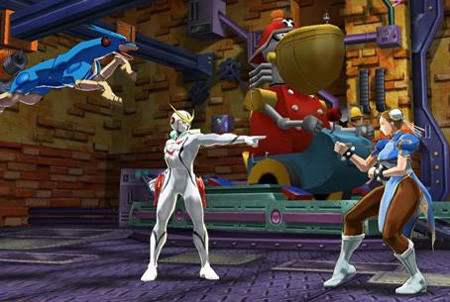
For those of you just joining us, Tatsunoko vs. Capcom: Ultimate All-Stars (as it'll be known in the West) is a fighting game that brings together combatants from numerous Capcom titles and many Tatsunoko shows, including Gatchaman, Gold Lightan, Yatterman, Karas, Casshern, and Hurricane Polymar. It's presented with 3-D graphics and 2-D gameplay, and like Capcom's other “Vs.” games, it's not quite as serious and demanding as a round of Street Fighter IV or The King of Fighters XII. The Wii version's also stuffed with multiplayer mini-games, which makes an online mode seem all the more appropriate.
EVANGELION 1.0 INSPIRES PSP GAME, MAYBE
Yeah, Evangelion: Jo is yet another game based on you-know-what, but this PSP title supposedly takes after the first of the new Evangelion movies, You Are (Not) Alone. That's the word, though I note that screens for the game show both Kaoru and Zeruel, that one big Angel with the metal-cutter arms. Neither was in the first film.
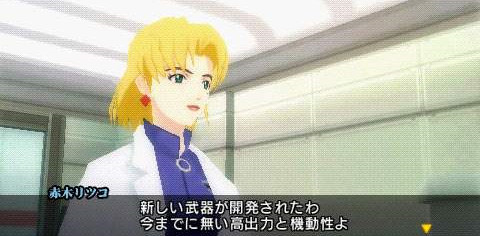
Jo recreates at least four Angel battles from the series by making players jab various buttons to match on-screen prompts. It sounds dangerously like that Nintendo 64 Evangelion game, though the developer went through the trouble of rendering Jo's story scenes with rough-edged polygon versions of Shinji, Asuka, and the rest of the Evangelion cast. It might have the new four-legged EVA unit from the second movie, though Gainax will likely save that for the next PSP game.
IN BRIEF: TRI-ACE RPG RENAMED, FINAL FANTASY IV SEQUEL OUT SOON, SHINING DRAGON ON HOLD
Take note: tri-Ace and Sega's new RPG End of Eternity is now known as Resonance of Fate as far as English speakers are concerned. Sega's end put together a new trailer that plays up all of the action in the RPG's futurepunk world, with ashen industrialized cities and falling girls and Final Fantasy heroes shooting things.
Fun. It'll be out here for the 360 and PlayStation 3 by the spring of 2010.
Far closer to American RPG fans is Final Fantasy IV: The After Years, the multi-part epilogue to the RPG that made me buy a Super NES 18 years ago. The first episode arrives on WiiWare June 1, and the first English trailer says that this installment is the first of nine. That's slightly better than the game's original form in Japan, where it was portioned out for cell phones in twelve separately priced chunks. There's no price announced yet, and yet I have the sinking feeling that it'll cost at least 1000 points per episode, bringing the entire game in at $90. But hey, there's a multiplayer feature where three other players can command party members.
Remember how Valcon Games was going to release Shining Dragon, an Ikki Tousen title for the PlayStation 2, in America? Well, the game's now on hold, according to Siliconera. It seems that Valcon is at an impasse. Shining Dragon earned an M rating for displaying the characteristic clothes-ripping of Ikki Tousen, and such a label would damage its sales among the teenage crowd. If Valcon censors the game, that'll drive away Ikki Tousen fans (who actually exist in numbers large enough to keep buying the anime and manga). That's a rough break, though I doubt Shining Dragon would be a contender for anyone's best-of-2009 lists, to put it nicely.
Lastly, Square Enix unveiled Dragon Quest Wars for the DSiWare service. A downloadable title that uses the iconic Dragon Quest slime and other monsters in a board-game simulation, Wars leans heavily on the online multiplayer angle. It's only for Japan at the moment, but it should have no problem making its way over here.
FEATURE: MECHA GAMES
BORDER BREAK
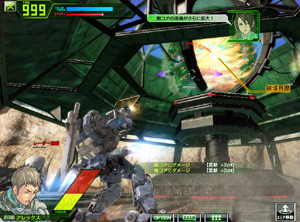 If arcades are going to survive in Japan, they might just do it by embracing multiplayer simulations of mecha-filled anime. Bandai's Gundam: Senjo no Kizuna was as successful as an arcade game can be when it requires a huge, ball-shaped cockpit for each player. Sega's going for a more modestly outfitted experience with Border Break. Developed by the company's AM2 division, Border Break resembles many of the recent Gundam games in perspective; the player outfits a gray military mecha, picks an anime portrait to pilot it, and heads out jumping, running, shooting, and squawking commands across a battlefield. There's a single-player mode, but Border Break is obviously for the multiplayer set, and the arcade version supports teams of ten players each fighting it out online. Combat machines come in four varieties: the basic Assault model, a Sniper class, a Heavy Arms carrier, and a “Support” mecha that sounds rather dull. The game almost seems too gritty to be rightly compared to operatic Gundam fare; the mecha are speedy, efficient things sprouting rifles and huge switchblade swords, looking more like they came from Gasaraki, Flag, or some other Ryosuke Takahashi exercise in robot-anime realism.
If arcades are going to survive in Japan, they might just do it by embracing multiplayer simulations of mecha-filled anime. Bandai's Gundam: Senjo no Kizuna was as successful as an arcade game can be when it requires a huge, ball-shaped cockpit for each player. Sega's going for a more modestly outfitted experience with Border Break. Developed by the company's AM2 division, Border Break resembles many of the recent Gundam games in perspective; the player outfits a gray military mecha, picks an anime portrait to pilot it, and heads out jumping, running, shooting, and squawking commands across a battlefield. There's a single-player mode, but Border Break is obviously for the multiplayer set, and the arcade version supports teams of ten players each fighting it out online. Combat machines come in four varieties: the basic Assault model, a Sniper class, a Heavy Arms carrier, and a “Support” mecha that sounds rather dull. The game almost seems too gritty to be rightly compared to operatic Gundam fare; the mecha are speedy, efficient things sprouting rifles and huge switchblade swords, looking more like they came from Gasaraki, Flag, or some other Ryosuke Takahashi exercise in robot-anime realism.
Border Break is more than just a multiplayer arcade game. It's a showcase for Sega's new Ringedge and Ringwide hardware, which some desperate fans have mistaken for the roots of a new Sega home console that will destroy all competition and ascend with the Sega faithful to a lofty Nirvana where people still care about Alex Kidd and Gunvalkyrie. Ringedge and Ringwide are just arcade systems running Windows Embedded Standard 2009, so zealots are better off envisioning all of the new arcade games Sega might make and port to home systems.
VIRTUAL ON
If Border Break's multiplayer skirmishes and gunmetal mecha seem confusing and repulsively down to earth, there's always the one-on-one alternative of Sega's other big robot-battle series, Virtual On. The first game in the line was an imposing, dual-joystick arcade beast in 1996, yet the home versions of both it and its sequel, Virtual On: Oratorio Tangram, drew a following devoted enough to buy specialized controllers to mimic the arcade version's controls. In fact, Virtual On fandom is such that Hajime Katoki's robot designs, which didn't have much personality to start with, have been turned into novelty toys and inserted in Super Robot Wars games. There were two further sequels, the arcade-only Virtual On Force and the PlayStation 2's Virtual On Marz, but it's usually Oratorio Tangram that the crowds like best. So it's Oratorio Tangram that Sega recently released on Xbox Live.

As an arena-based combat game, Virtua On: Oratorio Tangram goes well beyond the restrictions of the typical 3-D fighter. Two mechs are dropped into a squarish battlefield and carry out a dashing, exploding, laser-spewing battle among trees and airport cargo. The lineup includes all sorts of robot types, from the lightweight pink Fei-Yen to the heavy Raiden, and each of them bears unique attacks and strengths. It's a somewhat difficult game to master, since the control is based on manipulating two joysticks and their buttons in various combinations; experts, of course, turn their battles into a whirl of jump cancels, arcing dashes, and spinning missile-laser barrages. Newcomers will be confused. Part of that is due to the game's learning curve, and part of it's due to the Xbox 360 controller making it all less intuitive than the dual-joystick setup. At least it's not as awkward as it was with a stock Dreamcast pad back in 2000. Unlike that arrangement, Oratorio Tangram on Xbox Live can still be learned, played, and enjoyed. Besides, there's no expensive specialized joystick to buy this time.
LINEBARRELS OF IRON
 Not to pick on Gonzo when they're down, but I wonder if anyone cares about Linebarrels of Iron. Gonzo tried to sell it to Americans by premiering the mecha series at Anime Expo and showing it all subtitled and legit on Crunchyroll, but no one seemed to talk about it. Heck, news of it getting licensed was overshadowed by the fervor and outrage over FUNimation buying Strike Witches at the same time. Well, let's be fair: Linebarrels did have a certain reputation as a manga, and it might carry over into Hudson's new strategy-RPG.
Not to pick on Gonzo when they're down, but I wonder if anyone cares about Linebarrels of Iron. Gonzo tried to sell it to Americans by premiering the mecha series at Anime Expo and showing it all subtitled and legit on Crunchyroll, but no one seemed to talk about it. Heck, news of it getting licensed was overshadowed by the fervor and outrage over FUNimation buying Strike Witches at the same time. Well, let's be fair: Linebarrels did have a certain reputation as a manga, and it might carry over into Hudson's new strategy-RPG.
Hudson maintains that Linebarrels of Iron for the PSP is an all-new story, but it's clearly set within the continuity of the little-loved anime series. Amid plenty of clips from that anime, the first trailer for the game shows off some 3-D battle scenes and a grid for positioning Machina units. As is the wont of anime-based games, the story has the cast of Linebarrels, from the Conflicted Young Hero to the Mysterious Girl, yap about events in static conversations. It'll be out in the fall in Japan and...eh, probably never in America.
RELEASES FOR THE WEEK OF 5-24
CRIMSON GEM SAGA Astonishia Story went largely unnoticed when it arrived on the PSP in 2005, possibly because its title sounded like it came from an unfinished fantasy novel by an author who's never read any of the book's made-up names out loud. Atlus will have none of that, so the sequel is called Crimson Gem Saga instead of Astonishia Story 2: Fate to Unhorse One. It's still a Korean-made take on the anime-style console RPG, with turn-based battles and sprite graphics reminiscent of the Super NES era. The plot itself has similar echoes, pairing an unlucky hero with a pink-haired elf thief and throwing them into a war over an ancient bauble. Atlus is quick to downplay comparisons to Astonishia Story, and to their credit, Crimson Gem Saga sports far more impressive diagonally viewed scenery, a battle system that sheds the original's strategic clogs, and what's sure to be a more coherent localization than the previous game (Atlus overhauled the English text from Crimson Gem Saga's Asian version). Perhaps the switch in title may confuse some fans, but leaving the Astonishia name behind can only improve this series.
|
CROSS EDGE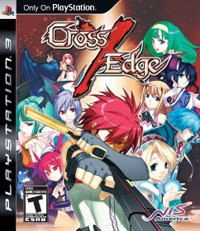 Developer: Compile Heart
Developer: Compile HeartPublisher: NIS America Platform: PS3 MSRP: $49.99
Cross Edge makes me wonder why Namco X Capcom never came out here. It couldn't have been legal matters, for if NIS America can publish a crossover between five companies, a game spanning two wouldn't have posed a problem. Capcom is the biggest name in Cross Edge, and they're lending only characters from Darkstalkers: Dimitri, Morrigan, Felicia, Lilith, and apparently even Jedah (the lack of Jon Talbain and B.B. Hood is distressing). They join representatives from various niche RPG publishers: NIS's Disgaea supplies Etna and some Prinnies; Gust's Atelier series offers Marie; Gust's Mana Khemia 2 contributes Raze, Lily, Whim, and Reicher; the original Ar Tonelico (also by Gust, which clearly had something invested here) throws in Lyner, Aurica, Misha, Ayatane, Shurelia, and Bourd; and Idea Factory adds Meu from Spectral Souls and Zelos from the recent Absolute Blazing Infinity. There's also a host of original characters to encounter in the game's dialogue scenes (featuring Japanese or English voices) and side-scrolling dungeons. The game's battles play out like the side-view encounters from Mana Khemia or Ar Tonelico, but with grids and a heavy emphasis on stringing together attacks by as many characters as possible. As you might expect from an RPG so influenced by the otaku sector, female characters can gain new abilities by changing their outfits.
|
NARUTO SHIPPUDEN: NINJA COUNCIL 4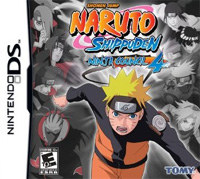 Developer: Aspect Digital Entertainment
Developer: Aspect Digital EntertainmentPublisher: Tomy Platform: DS MSRP: $29.99 Naruto Shippuden's debut in North America was a lot quieter than I expected, but we're unquestionably past that time when Naruto's license-holders excised Shippuden characters from video games for the Western hordes. Ninja Council 4, for example, is rooted in the new version of Naruto, from a plot that follows the first Shippuden arc to the manifold attacks employed by the five primary characters and their lineup of supporters. The fourth Ninja Council lets players use such new features as a three-ninja support team and regenerating health, but it preserves previous Ninja Councils' side-scrolling gameplay and looks only a little sharper. Not that Naruto fans will mind the familiarity, because it's Shippuden and it lets them use 17 different characters in a four-player versus mode.
|
RAIDEN FIGHTERS ACES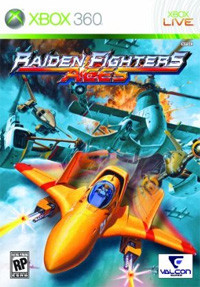 Developer: Seibu Kaihatsu Inc./Guilti Inc.
Developer: Seibu Kaihatsu Inc./Guilti Inc.Publisher: Valcon Games Platform: Xbox 360 MSRP: $19.99 OK, I admit that Raiden Fighters Aces slipped by me last week, which is shameful for anyone who likes shooters. I forgive myself. I suspect it's going to slip by an awful lot of people, since it's one of those budget-priced games that GameStop rarely stocks and other retailers don't even acknowledge. But it should be noticed by any shooter fan, since it represents the ideal evolution of the Raiden series. Many Western arcade-goers stopped paying attention around Raiden II or Raiden DX, yet the franchise continued with the Fighters series, a line of hectic 2-D shooters distinguished by the variety of ships available. The lineup includes the jets from the original Raiden, a bunch of new fighters, and even the ship from Viper Phase 1, Seibu Kaihatsu's aborted attempt at starting a new shooter series that was Raiden in space. Aces has the first Raiden Fighters, Raiden Fighters 2, and Raiden Fighters Jet, all for $20. Not a bad deal, even if you're forced to buy it online.
|
STEAL PRINCESS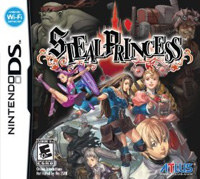 Developer:Climax Entertainment
Developer:Climax EntertainmentPublisher: Atlus Platform: DS MSRP: $29.99 Steal Princess is likely to be the most obscure Atlus release of this year, seeing as how GameStop is currently refusing to stock it. Not that it's due to a lack of quality. Like Climax's old Landstalker from the Sega Genesis days, Steal Princess uses a diagonal perspective for an intricately designed action-RPG. The emphasis here is on stealth and puzzle-solving as an eye-patching, whip-cracking thief named Anise stumbles into a battle against an ancient demon. The stages all have certain objectives, and Anise tosses around items and swings on her whip to carry them out. It helps that Steal Princess has a level-editing option, and any trap-laden stages that players create can be shared online. Atlus is also bundling the game with a small poster, much like they did with the second Izuna title. |
EXTRA LIVES: TAIYO NO YUSHA FYVARD
 Sun Brave Fyvard, or Taiyo no Yuusha Fyvard, is one of the lesser-known members of Sunrise and Takara's Brave anime franchise. Like most of the Brave series that aren't GaoGaiGar, Fyvard was never released in North America, and no English-speaking fan cares about it enough to even write up a Wikipedia entry or nail down a proper spelling for “Fyvard” (I think “Firebird” sounds best, but I'm sticking to the ANN Encyclopedia name for now). However, each Brave series had its season in the spotlight over in Japan, and Fyvard's 1992 moment of glory was marked by a Famicom game.
Sun Brave Fyvard, or Taiyo no Yuusha Fyvard, is one of the lesser-known members of Sunrise and Takara's Brave anime franchise. Like most of the Brave series that aren't GaoGaiGar, Fyvard was never released in North America, and no English-speaking fan cares about it enough to even write up a Wikipedia entry or nail down a proper spelling for “Fyvard” (I think “Firebird” sounds best, but I'm sticking to the ANN Encyclopedia name for now). However, each Brave series had its season in the spotlight over in Japan, and Fyvard's 1992 moment of glory was marked by a Famicom game.
Surprisingly, Sunrise and Takara didn't turn to Bandai to crap them out a Fyvard game. Instead, it was Irem, makers of the well-regarded R-Type series and other shooters, who caught the license and turned it over to their Tokyo-based subsidiary, Tamtex. Despite having a name befitting a feminine hygiene product, Tamtex is fondly remembered as the developer that gave us Metal Storm for the NES in 1991. Metal Storm is an excellent action game with a unique gravity-reversing mechanic, and it's one of the best mecha-centric titles on the system. In contrast, Tamtex's Fyvard game is one of the most boring shooters released on either the NES or Famicom.
Fyvard knows where the money's at, so it begins with a conversation between the show's villains followed by responses from the heroic Yutaro, Kenta, and Dr. Amano, most of whom are presented as disembodied heads floating in blackness. The player then chooses a character and, with him, a difficulty level: grade-school Kenta represents the easy mode, Yutaro the almost-as-easy mode. From there, the game rolls out the first of its vertically scrolling levels, letting the player pilot one of the Fyvard toy line's five robot-forming vehicles at any time. You're free to switch between a tank, a drilling vehicle, a rocket-launching 18-wheeler, a spread-firing plane, or a red bomber that creates fiery circles around itself.
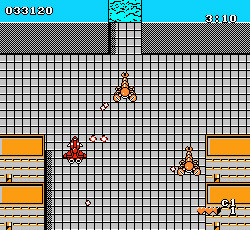 At first, Fyvard doesn't seem so bad. Testing each of the game's vehicles kills some of the initial level's tedium, and the graphics show off large sprites for an NES-level game. Unfortunately, it soon becomes apparent that Tamtex didn't want to scare off even the youngest of toy-wanting Fyvard fans. The game is excruciatingly slow, dropping in only one or two enemies at time. While each stage has items to gather (or destroy), power-ups to grab, and tiny human figures to rescue, everything just inches along at a horrible, unchallenging crawl. There's little advantage in switching vehicles; the ground ones are forced into narrow paths by the terrain, while the two jets simply fly over everything. Maybe players were supposed to switch to the rolling vehicles just to break up the monotomy.
At first, Fyvard doesn't seem so bad. Testing each of the game's vehicles kills some of the initial level's tedium, and the graphics show off large sprites for an NES-level game. Unfortunately, it soon becomes apparent that Tamtex didn't want to scare off even the youngest of toy-wanting Fyvard fans. The game is excruciatingly slow, dropping in only one or two enemies at time. While each stage has items to gather (or destroy), power-ups to grab, and tiny human figures to rescue, everything just inches along at a horrible, unchallenging crawl. There's little advantage in switching vehicles; the ground ones are forced into narrow paths by the terrain, while the two jets simply fly over everything. Maybe players were supposed to switch to the rolling vehicles just to break up the monotomy.
Fyvard tries to add some variety (and feature more toys) by giving the player control of a larger ship halfway through each level. While this abandons the vehicle-switching, the new jet cruiser can stock different weapons, including a chargeable shot and homing missiles that easily destroy foes. After drifting through this for a while, the player's told to transform into the true reason the game exists: the giant robot Fyvard. A brief cutscene plays, and the mecha trots through yet another top-down shooting level, aided by the same weapons that the flagship had before. Each level concludes with a fight against a huge robotic boss, all of which go down after a few fully charged Fyvard shots.
 The numbing pace makes Fyvard seem longer than its four levels. Instead of making a game that could conceivably kill the player, Tamtex simply made it move as sluggishly as possible and added two difficulty levels that aren't all that different. Yutaro's version of the game offers more enemies and tighter situations than Kenta's, but it's still grinding and dull. It kills the soundtrack, too. Most of the music is catchy for a few seconds, only to loop repeatedly and drive any sane player to mute it.
The numbing pace makes Fyvard seem longer than its four levels. Instead of making a game that could conceivably kill the player, Tamtex simply made it move as sluggishly as possible and added two difficulty levels that aren't all that different. Yutaro's version of the game offers more enemies and tighter situations than Kenta's, but it's still grinding and dull. It kills the soundtrack, too. Most of the music is catchy for a few seconds, only to loop repeatedly and drive any sane player to mute it.
Metal Storm shows that Tamtex was clearly capable of better things, and it's evident that the developer was simply paying Irem's bills with its Fyvard game. Perhaps Tamtex was also a tad bitter that Metal Storm, a superior mecha-action game, didn't sell as well as any given Gundam title or anime tie-in. Either way, Fyvard would be one of the last games created under the Tamtex label, as the company became Irem's Tokyo office shortly thereafter, moving on to greater things. The Brave series did pretty much the same. The games it inspired in the late 1990s are far more interesting, if only for representing the canceled Brave series Baan Gaan. But that's another story entirely.
Taiyo no Yuusha Fyvard, in all of its variant spellings, can be had for about $15 in plain cartridge form. A complete copy runs around $25, but I really doubt that anyone beyond Brave series fans will want it. And they're better off buying toys.
discuss this in the forum (40 posts) |
 Developer: Sonnori/Ntreev Soft
Developer: Sonnori/Ntreev Soft